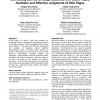Free Online Productivity Tools
i2Speak
i2Symbol
i2OCR
iTex2Img
iWeb2Print
iWeb2Shot
i2Type
iPdf2Split
iPdf2Merge
i2Bopomofo
i2Arabic
i2Style
i2Image
i2PDF
iLatex2Rtf
Sci2ools
CHI
2009
ACM
2009
ACM
Correlating low-level image statistics with users - rapid aesthetic and affective judgments of web pages
In this paper, we report a study that examines the relationship between image-based computational analyses of web pages and users’ aesthetic judgments about the same image material. Web pages were iteratively decomposed into quadrants of minimum entropy (quadtree decomposition) based on low-level image statistics, to permit a characterization of these pages in terms of their respective organizational symmetry, balance and equilibrium. These attributes were then evaluated for their correlation with human participants’ subjective ratings of the same web pages on four aesthetic and affective dimensions. Several of these correlations were quite large and revealed interesting patterns in the relationship between low-level (i.e., pixel-level) image statistics and designrelevant dimensions. Author Keywords Low-level features; image statistics; computer vision; user interface design; aesthetic judgments; empirical methods ACM Classification Keywords H5.2. Information interfaces and presen...
| Added | 22 Jul 2010 |
| Updated | 22 Jul 2010 |
| Type | Conference |
| Year | 2009 |
| Where | CHI |
| Authors | Xianjun Sam Zheng, Ishani Chakraborty, James Jeng-Weei Lin, Robert Rauschenberger |
Comments (0)

